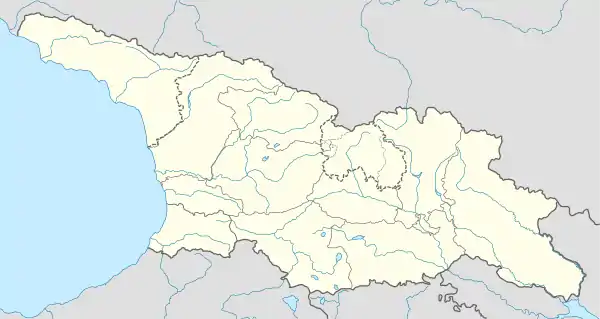Avranlo fortress
The Avranlo fortress (Georgian: ავრანლოს ციხე, romanized: avranlos tsikhe) is a megalithic structure in the Tsalka Municipality in Georgia's south-central region of Kvemo Kartli. A cyclopean fortification built using a dry masonry technique, it is located 0.5 km northwest of the eponymous village, on the left bank of the Ktsia river, at 1640 m above sea level. It dates to the last quarter of the 1st millennium BC.[1][2]
| ავრანლოს ციხე | |
 Avranlo fortress | |
 Location in Georgia | |
| Coordinates | 41.662487°N 43.884049°E |
|---|---|
| Location | Tsalka Municipality, Kvemo Kartli, Georgia |
| Type | Cyclopean fortress |
Avranlo is a megalithic complex arranged in three tiers of terraces overlooking the river canyon. The lowest tier, at the base of the mount, consists of an approximately 80-meter-long semicircular wall, which stands 3 meters high in places. There is a single gate, 1.9 m high and 1.75 m wide, which is roofed with a monolith 2.2 m long and 1.8 m wide. Large stones are scattered elsewhere. Between this wall and the mount there is a small medieval Christian church and several caves nearby, collectively referred to as the Abibos monastery.[1][2]
The second and third tiers are genuine "cyclopean" structures, characterized by large rocks, dry-stone masonry, and an unusual mode of arrangement. The third, uppermost tier tops the mount. It has a rectangular ground plan, 25 m in length and 18 m in width. The walls are 3-4 m thick. The structure is significantly damaged and many parts of it have been obliterated. Archaeological digs at the adjacent fields, north of the megalithic fortress, yielded, in 2006, a Kura–Araxes culture-type settlement and a necropolis dating from the 12th-11th century BC.[1][2]
The fortress was inscribed on the list of the Immovable Cultural Monuments of National Significance of Georgia in 2007.[3] In September 2019, a multiyear archaeological research project was launched by Georgia's culture heritage authorities for further study and conservation of the country's megalithic complexes, including those at Abuli, Shaori, Avranlo, and Sameba.[4]
References
- "ავრანლოს (თეზი) ციკლოპური ციხე" [Avranlo cyclopean fortress] (in Georgian). კულტურული მემკვიდრეობის გის პორტალი [GIS-portal of Cultural Heritage of Georgia]. Retrieved 31 July 2019.
- Narimanishvili, Goderdzi; Amiranashvili, Juansher; Kvachadze, Marine; Shanshashvili, Nino (2010). "Archaeological sites at Avranlo". In Gamkrelidze, Gela; Vickers, Michael (eds.). Rescue archaeology in Georgia: The Baku-Tblisi-Ceyhan and South Caucasian pipelines (PDF). Tbilisi: Georgian National Museum. pp. 381–409. ISBN 978-99940-980-4-0.
- "List of Immovable Cultural Monuments" (PDF) (in Georgian). National Agency for Cultural Heritage Preservation of Georgia. Retrieved 3 July 2019.
- Peikrishvili, Tako (5 September 2019). "აბულისა და შაორის ციკლოპურ ნაგებობებს არქეოლოგები შეისწავლიან". samkhretis karibche (in Georgian). Retrieved 5 September 2019.